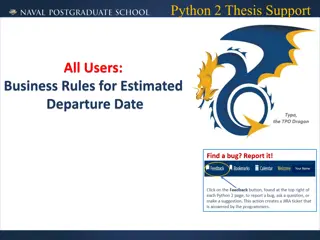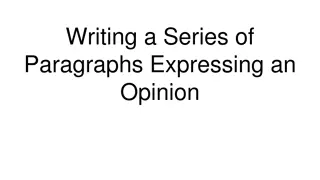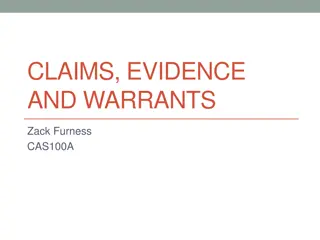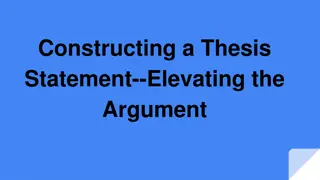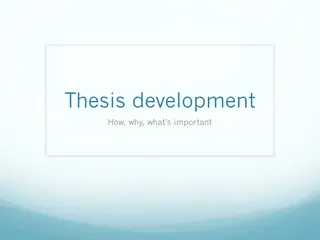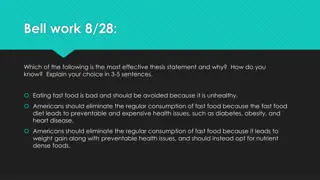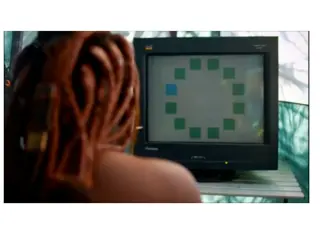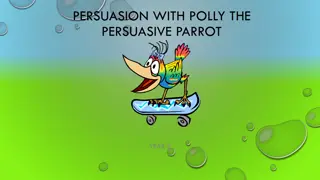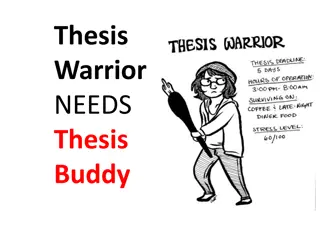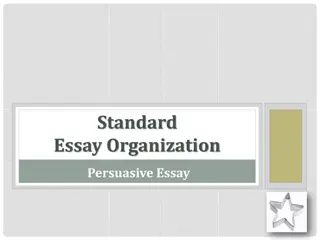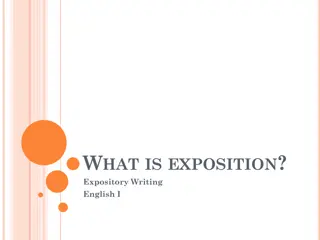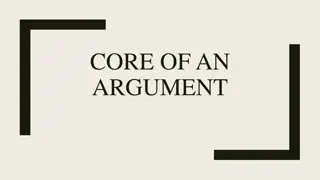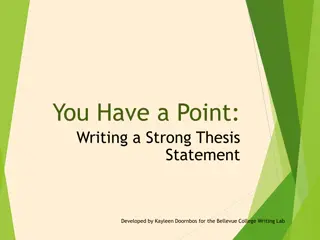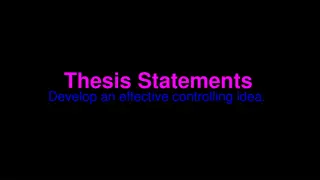Crafting a Persuasive Thesis Introduction
Dive into the strategic elements of a compelling thesis proposal introduction, showcasing the importance of setting the scientific narrative, outlining the unknown challenges of the topic, and emphasizing the impact of your research. Learn to structure your introduction with essential components like the goal, hook, background, and thesis statement, supported by adequate citations and subheadings.
Download Presentation

Please find below an Image/Link to download the presentation.
The content on the website is provided AS IS for your information and personal use only. It may not be sold, licensed, or shared on other websites without obtaining consent from the author.If you encounter any issues during the download, it is possible that the publisher has removed the file from their server.
You are allowed to download the files provided on this website for personal or commercial use, subject to the condition that they are used lawfully. All files are the property of their respective owners.
The content on the website is provided AS IS for your information and personal use only. It may not be sold, licensed, or shared on other websites without obtaining consent from the author.
E N D
Presentation Transcript
Anupam Saxena Associate Professor Indian Institute of Technology KANPUR 208016
Banana trick, orange trick! Geometric/PARAMETRIC Modeling Modeling of Surfaces (Patches) Modeling of Curves Solid Modeling Extended Jordon s curve Theorem A simple, closed Orientable surface bounds a Solid! Representatio n, Differential Geometry Perception of Solids Differential Geometry Topology and Solids Ferguson Segments Tensor Product Solid Modeling 1-2 Bezier Boundary Interpolating Segments 1-2 Transformatio ns and Projections 1-2 B-spline curves 1-5 Composite NURBS NURBS The bounding surface can be divided into surface patches Each patch has curved boundaries Both GEOMETRIC and CONNECTIVITY INFORMATION SHOULD BE STORED AND RETRIEVED! Each curve has end points!
Geometric/PARAMETRIC Modeling Modeling of Surfaces (Patches) Modeling of Curves Solid Modeling Representatio n, Differential Geometry Perception of Solids Differential Geometry Topology and Solids Ferguson Segments Tensor Product Solid Modeling 1-2 Bezier Boundary Interpolating Segments 1-2 Transformatio ns and Projections 1-2 B-spline curves 1-5 Composite NURBS NURBS
- Half-spaces are unbounded geometric entities Geometric/PARAMETRIC Modeling - they divide the representation space E3 into two infinite portions Modeling of Surfaces (Patches) Modeling of Curves Solid Modeling Representatio n, Differential Geometry Perception of Solids Differential Geometry Topology and Solids Ferguson Segments Tensor Product Solid Modeling 1-2 Bezier Boundary Interpolating Segments 1-2 - one filled with material while the other empty Transformatio ns and Projections 1-2 B-spline curves 1-5 Composite NURBS NURBS - Surfaces are half-space boundaries - half-spaces can be treated as directed surfaces the direction vector points towards the material side -
A half-space H can be defined as a regular point set in E3 such that H = {P| P E3 and f(P) < 0} f(P) = 0 defines the surface equation Geometric/PARAMETRIC Modeling Modeling of Surfaces (Patches) Modeling of Curves Solid Modeling Representatio n, Differential Geometry Perception of Solids Differential Geometry Topology and Solids Ferguson Segments Tensor Product Examples Planar half-space: Cylindrical half-space: H = {(x, y, z)| x2 + y2 < R2} Spherical half-space: H = {(x, y, z)| x2 + y2 + z2 < R2} Conical half-space : H = {(x, y, z)| x2 + y2 < tan2( /2)[z]2} Toroidal half-space with radii R1and R2: H = {(x, y, z)| (x2+ y2+ z2 R22 R12)2< 4R22(R12 z2)} Solid Modeling 1-2 Bezier Boundary Interpolating Segments 1-2 H = {(x, y, z)| z < 0} Transformatio ns and Projections 1-2 B-spline curves 1-5 Composite NURBS NURBS
- Complex objects can be modeled as half- spaces combined using set (union, subtraction) operations Geometric/PARAMETRIC Modeling Modeling of Surfaces (Patches) Modeling of Curves Solid Modeling Representatio n, Differential Geometry Perception of Solids Differential Geometry Topology and Solids Ferguson Segments Tensor Product Solid Modeling 1-2 Bezier Boundary Interpolating Segments 1-2 Transformatio ns and Projections 1-2 B-spline curves 1-5 Composite NURBS NURBS - Half-spaces acting as bounding patches for solids can be free form surfaces
H4 H1 H9 Geometric/PARAMETRIC Modeling Modeling of Surfaces (Patches) Modeling of Curves H7 Solid Modeling H8 Representatio n, Differential Geometry Perception of Solids Differential Geometry Topology and Solids Ferguson Segments Tensor Product H3 Solid Modeling 1-2 Bezier Boundary Interpolating Segments 1-2 Transformatio ns and Projections 1-2 B-spline curves 1-5 Composite NURBS NURBS H5 H2 H6 Let all be the directed surfaces s.t. the material points into the solid
H4 H1 H9 H7 Geometric/PARAMETRIC Modeling H8 Modeling of Surfaces (Patches) Modeling of Curves Solid Modeling H3 Representatio n, Differential Geometry Perception of Solids Differential Geometry Topology and Solids Ferguson Segments Tensor Product Solid Modeling 1-2 Bezier Boundary Interpolating Segments 1-2 H5 Transformatio ns and Projections 1-2 B-spline curves 1-5 Composite NURBS NURBS H2 H6 (H1 H2 H3 H4 H6 H7) (H4 H8 H5 H2 H3 H6) + (H9)
(a) be versatile and capable of modeling a generic solid Geometric/PARAMETRIC Modeling Modeling of Surfaces (Patches) Modeling of Curves (b) generate valid solids Solid Modeling Representatio n, Differential Geometry Perception of Solids Differential Geometry Topology and Solids Ferguson Segments Tensor Product (c) be complete in the sense that every valid representation (solid) produced is unambiguous Solid Modeling 1-2 Bezier Boundary Interpolating Segments 1-2 Transformatio ns and Projections 1-2 B-spline curves 1-5 Composite NURBS NURBS (d) generate unique solids in that no two different representations should generate the same object (e) have closure implying that permitted transformation operations on valid solids always yield valid solids (f) be compact and efficient in matters of data storage and retrieval.
Wireframe approach Geometric/PARAMETRIC Modeling Modeling of Surfaces (Patches) Modeling of Curves Boundary Representation Approach Solid Modeling Representatio n, Differential Geometry Perception of Solids Differential Geometry Topology and Solids Ferguson Segments Tensor Product Solid Modeling 1-2 Bezier Boundary Interpolating Constructive Solid Geometry More catered to modeling Segments 1-2 Transformatio ns and Projections 1-2 B-spline curves 1-5 Composite NURBS NURBS Work well for Polyhedral solids Can be extended for use with homeomorphic non-polyhedral solids
one of the oldest ways to represent solids Geometric/PARAMETRIC Modeling Modeling of Surfaces (Patches) Modeling of Curves Solid Modeling representation is essentially through a set of key vertices connected by key edges Representatio n, Differential Geometry Perception of Solids Differential Geometry Topology and Solids Ferguson Segments Tensor Product Solid Modeling 1-2 Bezier Boundary Interpolating Segments 1-2 Transformatio ns and Projections 1-2 B-spline curves 1-5 Composite NURBS NURBS both topological and (NOT ALL) geometric information is stored The edges may be straight or curved
Geometric/PARAMETRIC Modeling Modeling of Surfaces (Patches) Modeling of Curves Solid Modeling 4 Representatio n, Differential Geometry Edge Number 1 2 3 4 5 6 Perception of Solids Differential Geometry Vertex 1 1 2 1 1 3 2 Vertex 2 2 3 3 4 4 4 (5) Topology and Solids Ferguson Segments Tensor Product Solid Modeling 1-2 Bezier Boundary Interpolating (4) 3 Segments 1-2 Transformatio ns and Projections 1-2 B-spline curves 1-5 Composite (3) (6) NURBS NURBS (2) 1 Vertex Number 1 2 3 4 (1) x y z 2 z 0 0 0 y 1 4 0 x 3 2 0 1 2 4
8 Edge table 1 1 2 2 3 3 4 4 5 5 6 6 7 7 8 8 9 5 10 6 11 7 12 8 vertex table 1 0 0 0 2 10 0 0 3 10 10 0 4 0 10 0 5 0 0 10 6 10 0 10 7 10 10 10 8 0 10 10 Geometric/PARAMETRIC Modeling (12) 2 3 4 1 1 2 3 4 6 7 8 5 (11) Modeling of Surfaces (Patches) Modeling of Curves Solid Modeling Representatio n, Differential Geometry 7 Perception of Solids Differential Geometry (8) Topology and Solids Ferguson Segments Tensor Product 5 (10) (9) Solid Modeling 1-2 Bezier Boundary Interpolating Segments 1-2 Transformatio ns and Projections 1-2 6 B-spline curves 1-5 Composite (7) (5) 4 (3) NURBS NURBS (4) (6) 3 1 (2) (1) 2
wireframe models are simple, they are non-unique and ambiguous the models do not include the face information. Geometric/PARAMETRIC Modeling Modeling of Surfaces (Patches) Modeling of Curves Solid Modeling Representatio n, Differential Geometry Perception of Solids Differential Geometry Topology and Solids Ferguson Segments Tensor Product Solid Modeling 1-2 Bezier Boundary Interpolating Segments 1-2 Transformatio ns and Projections 1-2 B-spline curves 1-5 Composite NURBS NURBS
Geometric/PARAMETRIC Modeling Modeling of Surfaces (Patches) Modeling of Curves Solid Modeling Representatio n, Differential Geometry Perception of Solids Differential Geometry Topology and Solids Ferguson Segments Tensor Product Solid Modeling 1-2 Bezier Boundary Interpolating Segments 1-2 Transformatio ns and Projections 1-2 B-spline curves 1-5 Composite NURBS NURBS
B-rep for short an extension of wireframe modeling to include the face information The faces can either be analytical or free form surfaces B-rep uses the Jordan s curve theorem on boundary determinism a closed connected surface determines the interior of a solid both topological and geometric information is stored Geometric/PARAMETRIC Modeling Modeling of Surfaces (Patches) Modeling of Curves Solid Modeling Representatio n, Differential Geometry Perception of Solids Differential Geometry Topology and Solids Ferguson Segments Tensor Product Solid Modeling 1-2 Bezier Boundary Interpolating Segments 1-2 Transformatio ns and Projections 1-2 B-spline curves 1-5 Composite NURBS NURBS
Face orientations may be recorded such that a normal to the face points into the solid. Geometric/PARAMETRIC Modeling Modeling of Surfaces (Patches) Modeling of Curves Solid Modeling Representatio n, Differential Geometry Perception of Solids Differential Geometry Topology and Solids Ferguson Segments Tensor Product This can be ensured by the clockwise ordering of vertices (right-handed rule) associated with the face Solid Modeling 1-2 Bezier Boundary Interpolating Segments 1-2 Transformatio ns and Projections 1-2 B-spline curves 1-5 Composite NURBS NURBS Using normal vectors, one can distinguish the interior of the solid from its exterior
Geometric/PARAMETRIC Modeling Modeling of Surfaces (Patches) Modeling of Curves Solid Modeling Representatio n, Differential Geometry Perception of Solids Differential Geometry 4 Face 1: Face 2: Face 3: Face 4: 1, 4, 2 2, 4, 3 3, 4, 1 2, 3, 1 Topology and Solids Ferguson Segments Tensor Product (5) Solid Modeling 1-2 Bezier Boundary Interpolating Segments 1-2 Transformatio ns and Projections 1-2 (4) 3 B-spline curves 1-5 Composite NURBS NURBS (3) (6) (2) 1 (1) 2 z y x
Data storage method with B-Rep Employs only edges to document the connectivity Geometric/PARAMETRIC Modeling Modeling of Surfaces (Patches) Modeling of Curves Solid Modeling Representatio n, Differential Geometry Perception of Solids Differential Geometry Back face D Topology and Solids Ferguson Segments Tensor Product 4 (5) (6) Solid Modeling 1-2 Bezier Boundary Interpolating Segments 1-2 4 Transformatio ns and Projections 1-2 B-spline curves 1-5 Composite (6) NURBS NURBS A B B (5) 3 (3) A (3) (4) (2) C 2 1 (1) (2) (1) 2
Back face D 4 (5) (6) 4 Geometric/PARAMETRIC Modeling (6) Modeling of Surfaces (Patches) Modeling of Curves Solid Modeling Representatio n, Differential Geometry Perception of Solids Differential Geometry A B B (5) 3 (3) Topology and Solids Ferguson Segments Tensor Product A (3) Solid Modeling 1-2 Bezier Boundary Interpolating Segments 1-2 Transformatio ns and Projections 1-2 (4) (2) B-spline curves 1-5 Composite C 2 NURBS NURBS 1 (1) (2) (1) 2 Clockwise Traverse on Face 1 Clockwise traverse on Face 2 Edge Vertices Faces Face 1 Face 2 Preceding Edge Suceeding Edge Preceding Edge Suceeding Edge Name Start End (3) 2 4 A B (5) (1) (2) (6) (1) 1 2 A C (3) (5) (4) (2) (2) 2 3 B C (6) (3) (1) (4) (4) 1 3 D C (5) (6) (2) (1) (5) 1 4 D A (6) (4) (1) (3) (6) 3 4 B D (3) (2) (4) (5)
Geometric/PARAMETRIC Modeling Modeling of Surfaces (Patches) Modeling of Curves Solid Modeling Representatio n, Differential Geometry Perception of Solids Differential Geometry Topology and Solids Ferguson Segments Tensor Product vertex table face table Solid Modeling 1-2 Bezier Boundary Interpolating Segments 1-2 Transformatio ns and Projections 1-2 B-spline curves 1-5 Face Edge Composite Vertex Edge NURBS NURBS A (1) 1 (1) B (2) 2 (2) C (4) 3 (3) D (5) 4 (6) These are non-unique tables
Geometric/PARAMETRIC Modeling Modeling of Surfaces (Patches) Modeling of Curves Solid Modeling Representatio n, Differential Geometry Perception of Solids Differential Geometry Topology and Solids Ferguson Segments Tensor Product Solid Modeling 1-2 Bezier Boundary Interpolating Segments 1-2 Transformatio ns and Projections 1-2 B-spline curves 1-5 Composite NURBS NURBS When internal loops present (a) Assign them counterclockwise orientation OR/AND (b) Connect the internal loop with the external one using auxiliary edges Effectively, only one loop will be present An Auxiliary edge will have the same face on the left and right
How do we know a polyhedral solid is a valid solid? Geometric/PARAMETRIC Modeling V E + F (L F) 2(S G) = 0 * Modeling of Surfaces (Patches) Modeling of Curves Solid Modeling Representatio n, Differential Geometry Perception of Solids Differential Geometry Extended to include pot and through holes V as number of vertices, E as the number of edges, F as the number of faces, G as the number of holes (or genus) penetrating the solid, S as the number of shells and L as the total number of outer and inner loops Topology and Solids Ferguson Segments Tensor Product Solid Modeling 1-2 Bezier Boundary Interpolating Segments 1-2 Transformatio ns and Projections 1-2 B-spline curves 1-5 Composite NURBS NURBS a shell is an internal void of a solid bounded by a closed connected surface that can have its own genus value * For a valid solid, this is true. Converse, however, is NOT TRUE
Example 1: V = 8 E = 12 F = 6 L = 6 S = 1 G = 0 Geometric/PARAMETRIC Modeling Modeling of Surfaces (Patches) Modeling of Curves Solid Modeling Representatio n, Differential Geometry Perception of Solids Differential Geometry Topology and Solids Ferguson Segments Tensor Product Solid Modeling 1-2 Bezier Boundary Interpolating Segments 1-2 Transformatio ns and Projections 1-2 B-spline curves 1-5 Composite NURBS NURBS V E + F (L F) 2(S G) 8 12 + 6 (6 6) 2(1 0) = 0
Example 2: V = 16 E = 24 F = 11 L = 12 S = 1 G = 0 Geometric/PARAMETRIC Modeling Modeling of Surfaces (Patches) Modeling of Curves Solid Modeling Representatio n, Differential Geometry Perception of Solids Differential Geometry Topology and Solids Ferguson Segments Tensor Product Solid Modeling 1-2 Bezier Boundary Interpolating Segments 1-2 Transformatio ns and Projections 1-2 B-spline curves 1-5 Composite NURBS NURBS V E + F (L F) 2(S G) 16 24 + 11 (12 11) 2(1 0) = 0
Example 3: V = 16 E = 24 F = 10 L = 12 S = 1 G = 1 Geometric/PARAMETRIC Modeling Modeling of Surfaces (Patches) Modeling of Curves Solid Modeling Representatio n, Differential Geometry Perception of Solids Differential Geometry Topology and Solids Ferguson Segments Tensor Product Solid Modeling 1-2 Bezier Boundary Interpolating Segments 1-2 Transformatio ns and Projections 1-2 B-spline curves 1-5 Composite NURBS NURBS V E + F (L F) 2(S G) 16 24 + 10 (12 10) 2(1 1) = 0
Example 4: V = 24 E = 36 F = 16 L = 18 S = 2 G = 1 Geometric/PARAMETRIC Modeling Modeling of Surfaces (Patches) Modeling of Curves Solid Modeling Representatio n, Differential Geometry Perception of Solids Differential Geometry Topology and Solids Ferguson Segments Tensor Product Solid Modeling 1-2 Bezier Boundary Interpolating Segments 1-2 Transformatio ns and Projections 1-2 B-spline curves 1-5 Composite NURBS NURBS V E + F (L F) 2(S G) 24 36 + 16 (18 16) 2(2 1) = 0
Example 5: Geometric/PARAMETRIC Modeling V = 10 E = 15 F = 7 L = 7 S = 1 G = 0 Modeling of Surfaces (Patches) Modeling of Curves Solid Modeling Representatio n, Differential Geometry Perception of Solids Differential Geometry Topology and Solids Ferguson Segments Tensor Product Solid Modeling 1-2 Bezier Boundary Interpolating Segments 1-2 Transformatio ns and Projections 1-2 B-spline curves 1-5 Composite NURBS NURBS This is NOT a valid solid One face is dangling V E + F (L F) 2(S G) 10 15 + 7 (7 7) 2(1 0) = 0




